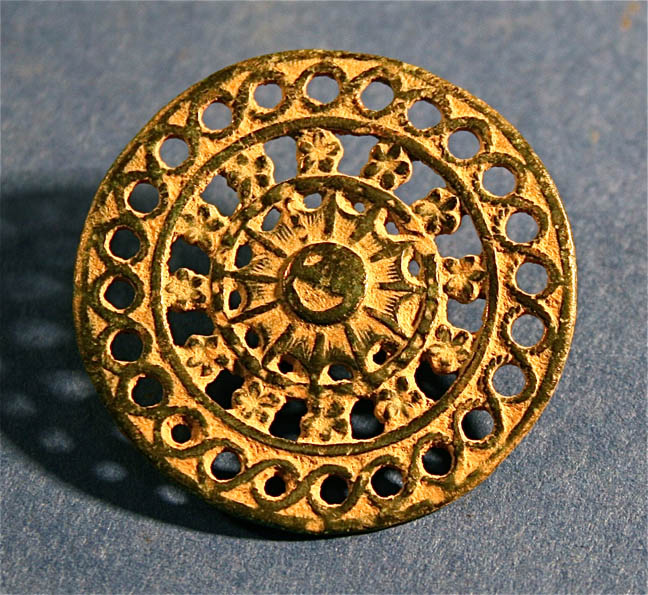

Title: Antique Bronze Button Roman Sun Wheel Design Ancient Artifact
Shipping: $9.00
Artist: N/A
Period: Antiquity
History: N/A
Origin: N/A
Condition: Excellent
Item Date: 2000 to 3000
Item ID: 4475
Roman button wheel design, handmade Ancient Artifact, excavated field molded cast button. The patina contains some verdigris. Typical and ancient, old bronze. This would be a fine addition to an artifact button collection. Though it is deteriorated, as you may see from the photos, the design on the front seems to be one of a kind. Buttons and button-like objects used as ornaments rather than fasteners have been discovered all around Ancient Rome. Some buttons were carved into geometric shapes and had holes pierced into them so that they could attached to clothing by using a thread. The button, in fact, was originally used more as an ornament than as a fastening. If you have more information concerning this object, its symbolism, its ritual use, its ethnos group, do not hesitate to leave us a comment, just email us.
Link: http://en.wikipedia.org/wiki/Button
In clothing and fashion design, a button is a small disc, typically round, an object usually attached to an article of clothing in order to secure an opening, or for ornamentation. Functional buttons work by slipping the button through a fabric or thread loop, or by sliding the button through a reinforced slit called a buttonhole. Buttons may be manufactured from an extremely wide range of materials, including natural materials such as antler, bone, horn, ivory, shell, vegetable ivory, and wood; or synthetics such as celluloid, glass, metal, bakelite and plastic. Buttons and button-like objects used as ornaments rather than fasteners have been discovered in the Indus Valley Civilization during its Kot Diji phase (circa 2800-2600 BC) as well as Bronze Age sites in China (circa 2000-1500 BCE), and Ancient Rome. Buttons made from seashell were used in the Indus Valley Civilization for ornamental purposes by 2000 BCE. Some buttons were carved into geometric shapes and had holes pierced into them so that they could attached to clothing by using a thread. Ian McNeil (1990) holds that: "The button, in fact, was originally used more as an ornament than as a fastening, the earliest known being found at Mohenjo-daro in the Indus Valley. It is made of a curved shell and about 5000 years old. Functional buttons, made from stone, have been found at the site of Gobekli Tepe, in southeastern Turkey, dated at 10,500 B.C.E. pictured in the article. Functional buttons with buttonholes for fastening or closing clothing appeared first in Germany in the 13th century. They soon became widespread with the rise of snug-fitting garments in 13th- and 14th-century Europe.